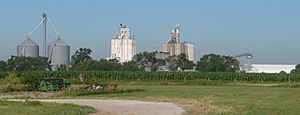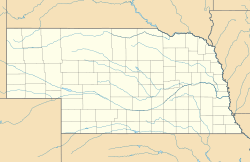Tamora, Nebraska facts for kids
Quick facts for kids
Tamora
|
|
|---|---|

View of Tamora from the northeast, July 2010
|
|
| Country | United States |
| State | Nebraska |
| County | Seward |
| First settled | 1879 |
| Area | |
| • Total | 0.99 sq mi (2.58 km2) |
| • Land | 0.99 sq mi (2.56 km2) |
| • Water | 0.01 sq mi (0.02 km2) |
| Elevation | 1,558 ft (475 m) |
| Population
(2020)
|
|
| • Total | 44 |
| • Density | 44.53/sq mi (17.19/km2) |
| Time zone | UTC-6 (Central (CST)) |
| • Summer (DST) | UTC-5 (CDT) |
| ZIP code |
68434
|
| Area code(s) | 402 |
| FIPS code | 31-48340 |
| GNIS feature ID | 2583900 |
Tamora (pronounced tə-MOR-ə) is a small community in Seward County, Nebraska, United States. It's called a census-designated place, which means it's an area identified by the U.S. Census Bureau for statistical purposes. Today, Tamora has a large complex of buildings for storing grain and a small area where people live. About 70 people call Tamora home.
Contents
History of Tamora
Early Days and Naming the Town
In 1877, the Burlington Railroad built its tracks further west from Seward, Nebraska. To encourage the railroad to add a stop and a station, four men each gave 10 acres (about 4 hectares) of their land in 1879.
There was a disagreement about what to name the new town. Each of the four men wanted it named after himself! They decided to put off the decision until later. Because of this, they chose the name "Tamora," which was a common way to say "tomorrow" back then.
Growth and Challenges
Within three years of its start, three large buildings for storing grain were built in Tamora. By 1884, about 53 people lived there. The town officially became a village in 1888. At one point, Tamora had over 30 businesses, including two banks and its own newspaper, the Tamora Times.
In 1892, some people tried to move the main government office (the county seat) of Seward County to Tamora. They even started building a courthouse. But the idea didn't get enough support, and the building was never finished. Later, someone tried to build an opera house on the same spot, but that also failed.
By 1920, Tamora's population grew to over 200 people. However, the town didn't have a fire department. Many of its businesses were destroyed by fires and were not rebuilt. Because of this, the number of people living in Tamora slowly went down. By 1980, only 50 people lived there. The local post office closed in 1970.
Grain Elevators and Unincorporation
Even as the town's shops and population decreased, the facilities for storing and loading grain grew. In 1962, the local farmers' cooperative built a concrete grain elevator. In 1964, they replaced a feed mill that had burned down. In 1978, they built one of the largest grain elevators in Nebraska.
Over time, there were disagreements among the leaders of the village. In 1997, the people of Tamora voted to stop being an official village. This process is called unincorporation. The vote was 30 to 6 in favor of unincorporation.
The last official count of people (census) before Tamora stopped being a village was in 1990, when 51 people lived there. In 2007, the population was estimated to be 70.
Geography of Tamora
Tamora is located about 6 miles (9.7 km) west of Seward, Nebraska, which is the county seat. It's roughly halfway between Seward and Utica, Nebraska. You can find Tamora about half a mile (0.8 km) south of U.S. Route 34, right along the BNSF Railway tracks.
Population Information
| Historical population | |||
|---|---|---|---|
| Census | Pop. | %± | |
| 2020 | 44 | — | |
| U.S. Decennial Census | |||
Economy of Tamora
Tamora doesn't have a traditional shopping area with many businesses. Its main business is the large grain elevator run by United Farmers Cooperative. This elevator can handle "unit trains," which are long trains that carry only one type of cargo, like grain, from one place to another without being broken up. The elevator can hold 2,318,000 U.S. bushels (about 81,600 cubic meters) of grain. Its train siding has enough space for 110 railroad cars.
See also
 In Spanish: Tamora (Nebraska) para niños
In Spanish: Tamora (Nebraska) para niños



